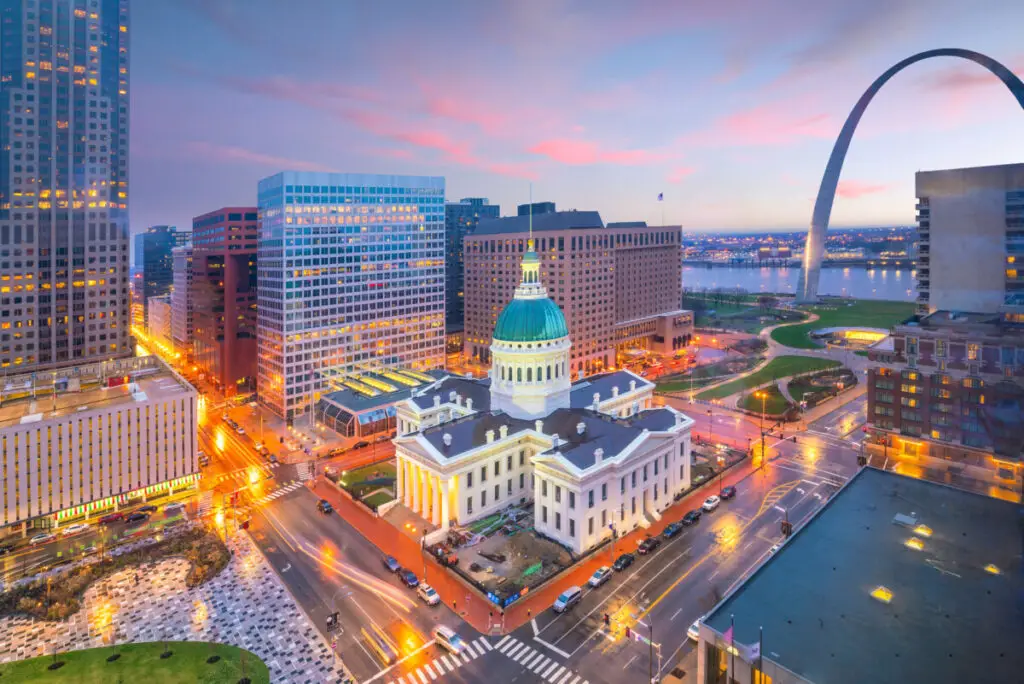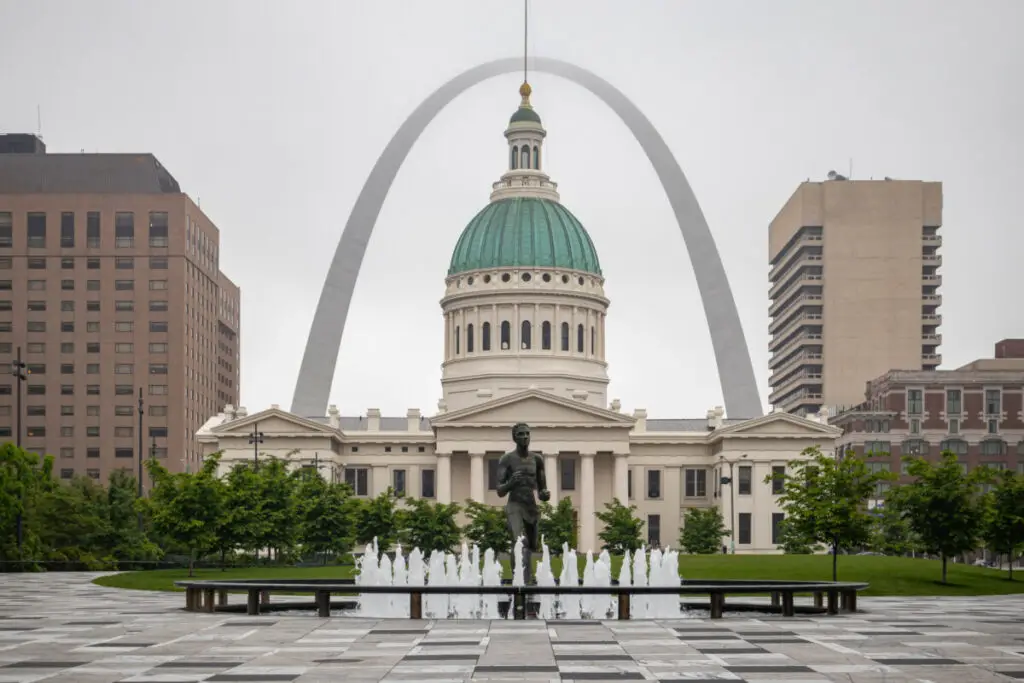
Politics are the source of a lot of controversies these days, and many people want those around them to have the same political beliefs that they do. Are the residents of St. Louis, Missouri more likely to be conservative or liberal?
St. Louis, Missouri is a very liberal city. The majority of residents have voted for the Democratic candidates in every presidential election since 2000. St. Louis County is also a very liberal area, while Missouri is a moderately conservative state.
There are a lot of factors to the political climate of a city. Looking at the results of presidential elections, local leaders, supported policies, and demographics of St. Louis can help us determine if the city is liberal or conservative.
Presidential Elections
The results of presidential elections in a city are a big indicator of whether that city is liberal or conservative. The two major political parties in the United States represent the liberal and conservative perspectives. The Democratic party has mostly liberal members and supports liberal policies. The Republican party has mostly conservative members and supports conservative policies. If the majority of residents in a city vote for the Democratic candidate, the city is mostly liberal. If the majority vote for the Republican candidate, the city is mostly conservative.
It is important to look not only at which candidate had the most votes, but also at how much they won by. In every election, a percentage of votes are for the Democratic candidate, and another percentage of the votes are for the Republican candidate. The difference between these percentages is how much the winning candidate won by. If the difference is high, the candidate won by a lot and the city is firmly liberal or conservative. If the difference is low, the city is closer to being evenly split between liberal and conservative.
Missouri is a moderately conservative state. The majority of Missouri residents voted for the Republican candidate in every presidential election since 2000. In 2016 and 2020, the difference between the percentages of Republican and Democratic votes was higher than 15%. In every other election, the percentage was below 10%. This means that, though the state was close to being evenly split at the beginning of the century, it has become firmly conservative in the past couple of years. The highest difference was 18.7% in 2016, and the lowest was 0.1% in 2008.
state. The majority of Missouri residents voted for the Republican candidate in every presidential election since 2000. In 2016 and 2020, the difference between the percentages of Republican and Democratic votes was higher than 15%. In every other election, the percentage was below 10%. This means that, though the state was close to being evenly split at the beginning of the century, it has become firmly conservative in the past couple of years. The highest difference was 18.7% in 2016, and the lowest was 0.1% in 2008.
In the 2020 presidential election, 56.8% of Missouri residents voted for the Republican candidate, and 41.4% voted for the Democratic candidate. The difference between the percentages was 15.4%, the second highest after 2016.
St. Louis County, the county in which the city of St. Louis is, is a very liberal area. The majority of residents voted for the Democratic candidate in every presidential election since 2000. In every election during that time except the 2000 election, the difference between the percentages of Democratic and Republican votes was higher than 60%. The highest difference was 68.05% in 2008, and the lowest difference was 57.52% in 2000.
area. The majority of residents voted for the Democratic candidate in every presidential election since 2000. In every election during that time except the 2000 election, the difference between the percentages of Democratic and Republican votes was higher than 60%. The highest difference was 68.05% in 2008, and the lowest difference was 57.52% in 2000.
In the 2020 presidential election, 81.93% of St. Louis County residents voted for the Democratic candidate, and 15.98% voted for the Republican candidate. The difference between the percentages was 65.95%, the third highest after 2008 and 2012.
St. Louis, like St. Louis County and unlike the state of Missouri, is a very liberal city . The Democratic candidate won in the city in every presidential election since 2000. In all of those elections, the difference between the percentages was over 10%. This means that the election wasn’t close to going the other way in the city, so St. Louis is firmly liberal.
. The Democratic candidate won in the city in every presidential election since 2000. In all of those elections, the difference between the percentages was over 10%. This means that the election wasn’t close to going the other way in the city, so St. Louis is firmly liberal.
From 2018 to 2021, there were 60,731 contributions to the Democratic party in St. Louis. These donations added up to $13,459,590. In contrast, there were only 4,758 contributions to the Republican party in St. Louis during that time, totaling $8,423,318. The donations to the Republican party were about 8 times higher on average than those given to the Democratic party.
Local Leaders

The local leaders of a city represent the political beliefs of the city. The residents vote for the local leaders based on their promises and beliefs. The enacted policies, campaign platforms, and party affiliations of the local leaders of St. Louis can help us figure out if the city is mostly liberal or conservative.
Mayor
The mayor of St. Louis is one of the most important elected officials. The mayor represents the city in state, national, and international matters. The mayor also proposes a budget, signs legislation, appoints certain government employees, and oversees the operations of the city.
The current mayor of St. Louis is Tishaura Jones . She was elected in 2021 and will serve until 2025. She won the general election with 52.0% of the vote, winning by 2,280 votes. She has been elected in government positions before, once as the St. Louis Treasurer and as a member of the Missouri House of Representatives.
. She was elected in 2021 and will serve until 2025. She won the general election with 52.0% of the vote, winning by 2,280 votes. She has been elected in government positions before, once as the St. Louis Treasurer and as a member of the Missouri House of Representatives.
Mayor Jones’s priorities in office have been promoting equality, recovering from COVID-19, addressing violent crime effectively, investing in small businesses, protecting children and youth, reforming tax incentives, and increasing the use of technology in government.
Mayor Jones’s initiatives have included the St. Louis Youth Development Collaborative, which has increased youth summer programs; the National Justice Database Study Findings, which analyzed the actions of the St. Louis Metropolitan Police Department; and the Domestic Violence Assaults Analysis of 2015 to 2021, which identified the best way to decrease domestic violence.
Mayor Jones is a member of the Democratic party. This supports the idea that she is of a liberal perspective. The priorities and initiatives that she has taken on also support this claim.
City Council
The City Council of St. Louis , which is also called the Board of Aldermen, is a board of elected officials that serve as the legislative body of the city. The city council adopts the budget, imposes taxes, and creates or changes laws. The city council has 29 members/alders. One, the president of the board, is elected by the whole city. The other 28 members are each elected by one of the city’s 28 wards.
, which is also called the Board of Aldermen, is a board of elected officials that serve as the legislative body of the city. The city council adopts the budget, imposes taxes, and creates or changes laws. The city council has 29 members/alders. One, the president of the board, is elected by the whole city. The other 28 members are each elected by one of the city’s 28 wards.
The current city council is made up of all nonpartisan members. However, the achievements and goals of the city council support the idea that the majority of members are liberal.
Policies
The policies that the residents of a city support are another indicator of the political climate. There are certain policies that tend to be supported or opposed by liberals or conservatives. Fewer abortion restrictions, more gun control laws, and legal same-sex marriage are all most likely to be supported by liberals and opposed by conservatives.
Abortions
Abortions in Missouri must be performed before 8 weeks of pregnancy unless the patient’s life is in danger. Patients must receive state-directed counseling at least 72 hours before an abortion can be provided. This counseling is designed to discourage the patient from getting an abortion. Private insurance policies, health plans, insurance policies for public employees, and public funding cannot cover abortions except in cases of life endangerment, rape, or incest. The parents of a minor must consent before an abortion can be provided to that minor.
of pregnancy unless the patient’s life is in danger. Patients must receive state-directed counseling at least 72 hours before an abortion can be provided. This counseling is designed to discourage the patient from getting an abortion. Private insurance policies, health plans, insurance policies for public employees, and public funding cannot cover abortions except in cases of life endangerment, rape, or incest. The parents of a minor must consent before an abortion can be provided to that minor.
In 2017, there were 4 facilities providing abortions in Missouri, 3 of which were clinics. 97% of counties do not have a clinic, leaving 78% of women without access to abortions.
St. Louis residents tend to oppose the high number of abortion restrictions, which is consistent with a liberal perspective.
Gun Control Laws
Missouri had the 4th highest gun death rate and the 23rd-highest crime gun export rate in 2020. Missouri gun laws include some open carry regulations and child access prevention laws. Missouri gun laws do not include universal background checks, gun owner licensing, domestic violence gun laws, assault weapon and large capacity magazine restrictions, waiting periods, and concealed carry laws.
some open carry regulations and child access prevention laws. Missouri gun laws do not include universal background checks, gun owner licensing, domestic violence gun laws, assault weapon and large capacity magazine restrictions, waiting periods, and concealed carry laws.
St. Louis residents tend to support an increase in gun control laws, which is consistent with a liberal perspective.
Same-Sex Marriage
Missouri legalized same-sex marriage on June 26, 2015 , and was one of the last states to do so. That day was when the Supreme Court mandate required all states to legalize same-sex marriage. St. Louis residents tend to support the legalization of same-sex marriage
, and was one of the last states to do so. That day was when the Supreme Court mandate required all states to legalize same-sex marriage. St. Louis residents tend to support the legalization of same-sex marriage
Demographics

The population of St. Louis is about 297,645 people, and the population density is about 4,821 people per square mile. 51.7% of the population is female and 48.3% is male. The median age is 34.4, and the number of people per household is 2.2.
of St. Louis is about 297,645 people, and the population density is about 4,821 people per square mile. 51.7% of the population is female and 48.3% is male. The median age is 34.4, and the number of people per household is 2.2.
The racial makeup of St. Louis is as follows:
of St. Louis is as follows:
- White: 42.9%
- Black: 47.5%
- Hispanic/Latino: 3.9%
- Asian: 3.1%
- Native American: 0.2%
- Hawaiian/Pacific Islander: 0.1%
- Two or More Races: 1.9%
- Other: 0.4%
85.7% of St. Louis residents are high school graduates and 21.8% are only high school graduates. 18.9% have two-year degrees, 34.1% have four-year degrees, 3% have master’s degrees, and 2.3% have professional degrees.
of St. Louis residents are high school graduates and 21.8% are only high school graduates. 18.9% have two-year degrees, 34.1% have four-year degrees, 3% have master’s degrees, and 2.3% have professional degrees.
51.6% of St. Louis residents are religious. 48.8% are Christian, 1.8% are Jewish, 0.8% are of an eastern faith, and 0.2% are affiliated with Islam.
of St. Louis residents are religious. 48.8% are Christian, 1.8% are Jewish, 0.8% are of an eastern faith, and 0.2% are affiliated with Islam.
The rate of violent crime in St. Louis on a scale of 1 to 100 is 86.8. The rate of property crime on the same scale is 85.1. Both are significantly higher than the national average.
in St. Louis on a scale of 1 to 100 is 86.8. The rate of property crime on the same scale is 85.1. Both are significantly higher than the national average.

